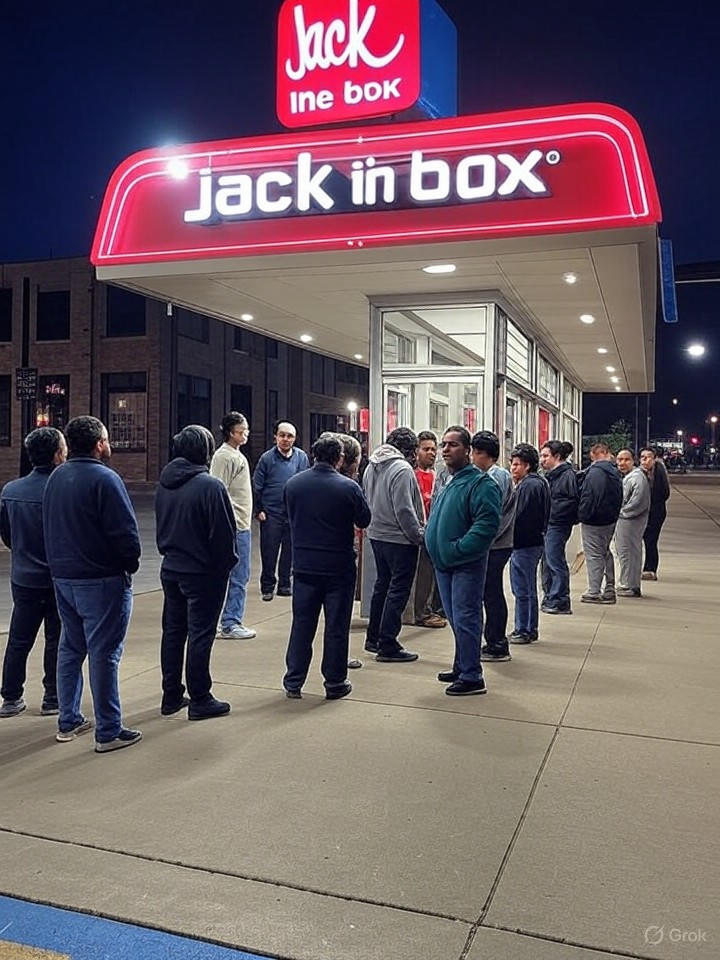After a 40-year hiatus, Jack in the Box has made a splashy return to the Chicago market, drawing long lines of nostalgic customers eager for its signature tacos and late-night munchies. The San Diego-based chain, known for its quirky mascot and 24-hour service, shuttered its last Chicago-area locations in the 1980s amid shifting consumer tastes and operational challenges. Now, with the fast-food industry fiercely competitive, the company’s re-entry is a calculated bet on untapped demand in a region dominated by giants like McDonald’s, which is headquartered nearby.
The first new outlet opened in July in Joliet, a converted Arby’s site that quickly became a hotspot, with drive-thru waits stretching up to an hour. According to a recent report in the Chicago Tribune, customers like 62-year-old retiree Dan Cudzik drove from afar to relive childhood memories, ordering classics such as two-for-99-cent tacos and egg rolls. Yet, the revival isn’t without tweaks: the iconic clown-head drive-thru speakers, a staple of the brand’s past, are absent in these modern setups, reflecting evolving design standards and cost efficiencies.
A Strategic Expansion Amid Economic Headwinds: Jack in the Box’s blueprint for Chicago involves eight company-operated stores slated for 2025, with ambitions for over 125 locations through franchising, signaling a bold push into a saturated Midwest market.
This expansion comes at a pivotal time for Jack in the Box Inc., which reported mixed third-quarter 2025 earnings, including an earnings-per-share miss that sent shares dipping, as detailed in a TradingView News analysis. Despite macroeconomic pressures affecting low-income consumers—a key demographic for the chain’s value-driven menu—the company remains optimistic, citing early Chicago sales as a bright spot. Posts on X (formerly Twitter) reflect buzzing excitement, with users sharing photos of packed lots and debating menu favorites, underscoring organic hype that could fuel growth.
Industry insiders note that Jack in the Box’s strategy hinges on its craveable, eclectic offerings, from Jumbo Jack burgers to stuffed jalapeños, which differentiate it from burger-focused rivals. A Restaurant Dive piece highlights how the chain plans to leverage 24/7 operations to capture night owls in a city where late-night options are plentiful but often limited. However, challenges loom: the brand must navigate rising labor costs and supply-chain issues, as evidenced by recent closures in other markets.
Navigating Consumer Shifts and Competitive Pressures: As Jack in the Box eyes suburban dominance, with sites planned near Midway Airport and in areas like Naperville, it faces questions about sustaining momentum in a region where health-conscious trends and digital ordering are reshaping dining habits.
Recent updates from local outlets, such as a Patch report on an upcoming Algonquin location, indicate openings accelerating into fall, including one in Carol Stream on Geneva Road. This aggressive timeline aligns with broader industry trends, where chains like Jack in the Box are acquiring assets—recall its 2021 purchase of Del Taco for $575 million, expanding its footprint to over 2,800 units nationwide, as noted in historical coverage from NBC Chicago.
For industry observers, the Chicago return is a litmus test for Jack in the Box’s adaptability. Amid questions raised in a Restaurant Business Online article about value strategies and digital innovation, the chain is rolling out app-based promotions to woo younger demographics. Early indicators, including strong same-store sales in new units, suggest potential, but sustaining loyalty against entrenched players will require more than nostalgia.
Looking Ahead: With franchise opportunities on the horizon and a focus on Hispanic consumers—who drive significant traffic per earnings call transcripts—the brand’s Chicago gamble could redefine its national trajectory if it balances innovation with its irreverent roots.
As the fast-food sector evolves, Jack in the Box’s re-emergence in Chicago encapsulates broader themes of revival and risk. Success here could pave the way for further Midwest incursions, much like its recent Georgia development deal for 15 units, as shared in industry buzz on X. Yet, with economic uncertainties persisting, the chain’s ability to convert long lines into lasting revenue will be closely watched by investors and competitors alike.




 WebProNews is an iEntry Publication
WebProNews is an iEntry Publication